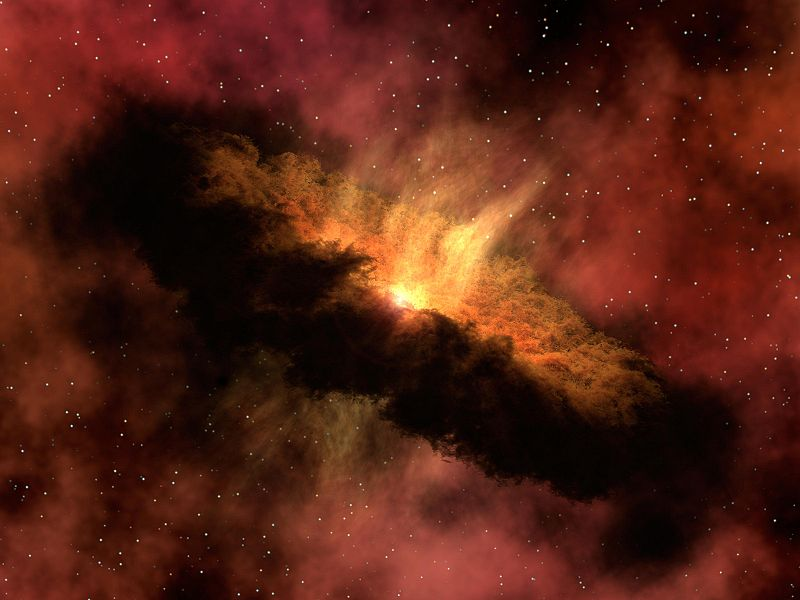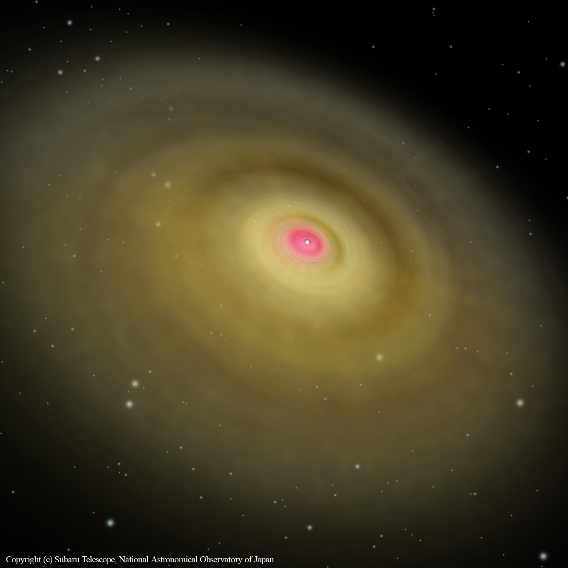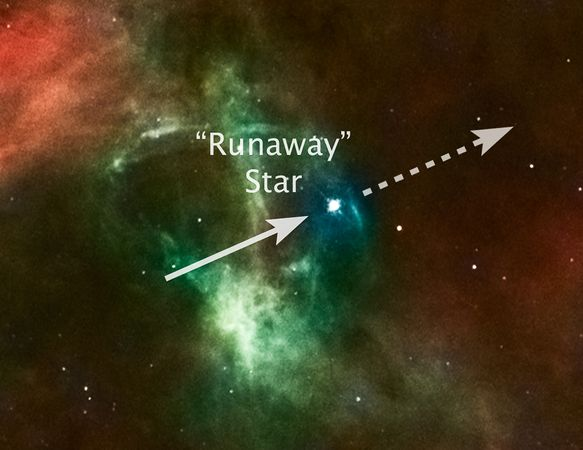Introduction
The origin of the Sun and its orbiting planets has been a point of hypothesis and conjecture ever since man looked upon the stars and planets and wondered about their origins. For the ancient Greek and Roman civilization the celestial bodies they observed in the sky were thought of as Gods and Goddesses, looking down up the Earth from some form of godlike platform. Today, it is an established fact that the heavenly bodies we see in the night sky are composed of planets and stars, celestial bodies of rock, gas and varying forms of elements that were formed billions of years ago. Even though such objects have been observed for hundreds of years it is only within the last 200 that humanity has begun to understand their unique qualities. While there have been conjectures, varying hypothesis and age old established theories what must be understood is that as the science of astronomy evolves humanity begins to slowly adapt to new information, new discoveries and subsequent re-evaluations of what we knew of as fact. For example, early studies of astronomy adopted the geocentric model in that they believed that the sun, planets, moon and stars revolved around the Earth, not only that there was also the belief that the Earth was in fact flat (Copernicus, 2009: 83). It is based on this that when examining the established theories on the origins of the solar system one must do so with both an open yet skeptical mind, taking into account the given data and observations yet not clearly adhering to any one theory as being definitive proof.
Another interesting topic that should be taken note of is the origin of the Earth itself for just as there have been numerous theories as to the origin of the solar system there have been a plethora of theories which have attempted to determine the origin of the Earth itself. Our home planet is unique in that it is the only planet within our solar system that has sufficiently developed to be able to support life. While there have been varying accounts of how life came to be on Earth, with religion and science vying for attention, the fact remains that the uniqueness of our planet should not be underestimated and as such bodes a certain degree of curiosity as to the origins of the unique circumstances that enabled Earth to become what it is today. It is based on the various questions presented that this paper will explore the origins of the solar system and of Earth itself in order to attain a clear picture of where it came from and what its possible end could be.
The Nebular Hypothesis

Currently, one of the most widely accepted theories regarding the formation of the solar system is that of the nebular hypothesis which states that the solar system originated from a molecular cloud wherein through the introduction of an external force caused a gravitational collapse of the fragment resulting in the creation of A pre-solar nebula that would eventually become our solar system (Glassmeier, 2006: 1 – 5). While there has been no definitive evidence as to the exact origin of the external force that caused a section of the molecular cloud to collapse rather than dispersing it into space it is theorized that the energy from a nearby supernova produced sufficient enough force to cause the collapse and help trigger the necessary events needed to create the solar system. While few studies dispute the nebular hypothesis several do call into question the theory that a supernova caused the initial collapse. Studies such as those by Woolfson (2010) state that the energies from a supernova instead of causing a section of the molecular cloud to collapse would have actually dispersed a majority of the cloud into space thus preventing the formation of the solar system (Woolfson, 2000: 1 – 15). Furthermore, while the nebular hypothesis has been well established as a guiding concept in understanding the creation of celestial bodies little is known as to the precise origins of the molecular cloud that gave birth to the solar system itself. Several scientists such as Lognonne et al. (2007) state that origin of the Sun and its surrounding planets was a molecular cloud and go to great lengths explaining how it led to the creation of the solar system yet a lot of studies neglect to mention how the molecular cloud came to be in the first place (Lognonne et al., 2007: 1 -3)
Origin of the Molecular Cloud

While this paper has so far expounded on the nebular theory involving the Solar system’s origins as coming from a giant molecular cloud a rather interesting question comes to mind, “if the origin of the solar system is that of a giant molecular cloud where did the molecular cloud come from?”. Studies such as those by Sorrell (2008) explain that while our own sun is 4.5 billion years old the age of the universe itself has been estimated at roughly 13.75 billion years (estimate subject to change due to varying accounts as to the proper calculation) (Sorrell, 2008: 45 – 49). Furthermore it must be noted that our sun is not the oldest sun in the universe let alone in our galaxy and in fact can be considered in the prime of its “youth” as a main sequence star (Naylor, 2009: 432). It has been theorized by researchers such as Freire (2008) that a few billion years after the Big Bang, Super Massive stars, many times the temperature of our current sun and several times its size, were among the first stars to form within the universe (Freire, 2008: 459-460). These celestial bodies were able to grow to such great size due to less “competition” for available materials in order to coalesce into stars; it must be noted though that at this point in time planets were unable to form due to the lack of heavier elements in which a sufficient enough solid mass could coalesce into a planet (Dessart, 2010: 2113-2125).
Rather interestingly, it was actually due to the inherent instability of Super Massive stars that the universe became what it is today; this is due to the theory that as a direct result of their internal instability most of the original Super Massive stars became supernovas which actually caused the original molecular clouds in the universe to form (Dessart et al., 2010: 2120 – 2125). The original state of the universe was actually more “pure” in the sense that there was a distinct lack of heavier elements, as such the question of “where did the heavier elements come from?” comes to mind. This is actually resolved by looking at the activity of our own sun wherein through a process called stellar nucleosynthesis in which the nuclear reactions within the sun itself is able to help build the nuclei of elements that are heavier than hydrogen (Chiosi, 2010).
Runaway Star Hypothesis

In relation to the explanation of the origins of the molecular cloud as coming from the debris from Super Massive stars Courtland (2010) presents a new theory that details exactly how the molecular cloud that spawned the solar system came to be. In her study which involved the examination of various meteorites she discovered that sealed within the rock were calcium-aluminum rich incisions (Al-26) that could only have been formed by stars that were at least 10 times as massive as the sun (Courtland, 2010: 8). Due to the fact that Super Massive stars usually form within clusters with Al 26 usually decaying rapidly due to the intense heat within such clusters it is hypothesized by Courtland (2010) that a run away must have been tossed out of its orbit as a direct result of either an explosion of a nearby Super Massive star or due to combined gravitational push by its sibling stars within the cluster (Courtland, 2010: 8). Due to Super Massive stars having a relatively short life cycle when the star became a supernova the dispersed molecules and elements became the molecular cloud that we know of today as being the primary basis of the nebular hypothesis.
Formation of the Sun and Planets
Creation of the Sun

Since this paper has now established the various theories which attempt to explain the origins of the molecular cloud that brought about the creation of the solar it is now necessary to explain the current prevailing theory on how the planets and the creation of the sun came about. As mentioned earlier, in the section detailing the nebular theory, it was explained that as a direct result of a gravitational collapse of a section of the molecular cloud this precipitated the creation of the solar system (Boeyens, 2009: 493-499). A better explanation of this would be that as section of the nebula collapsed this produced a certain degree of angular momentum wherein the nebula actually began to spin faster as it collapsed in on itself. This spinning combined within the collapse produced a great deal of kinetic energy within the core of the molecular cloud until the result was a contraction of the center of the molecular cloud, which had now become a disc shaped object, into what is known as a proto-star, namely a star that has yet to have hydrogen fusion occur at its core (Boeyens, 2009: 493-499). Within 50 million years the internal temperature and pressure of the core itself was able to build to sufficient levels resulting in the start of hydrogen fusion marking the entry of the sun into its life as a main sequence star (Boeyens, 2009: 493-499)
Theory of Accretion

The theory of accretion is currently the most widely accepted theory proposing the creation of the planets, in it the theory indicates that the leftover material from the sun’s creation continued to spin around the sun slowly clumping together piece by piece until larger dust shaped particles were created (Ogihara et al., 2007: 522-530). Gradually these dust particles also began clumping together resulting in the creation of larger and larger objects until finally the entire solar system was composed of literally dozens of moon sized objects that crashed into each over a period of several million years (Ogihara et al., 2007: 522-530). It must be noted that the reason why such a process didn’t just create a system of bits and pieces of rock is due to the fact that these moon sized objects actually had viscous outer cores in the sense that their composition was similar to lava due to the high temperatures of the sun at the time and the process of accretion itself. As such when the objects collided what resulted was not a titanic clash that mutually shattered the objects but rather a process where both objects combined to form a larger structure or surfaces were “swapped” in the sense that certain parts of either proto-planet’s surface accreted to the colliding object (Ogihara et al., 2007: 522-530).
Creation of the Earth
Originally the Earth was a proto-planet no bigger than the moon yet over several million years the process of accretion was able to slowly build up the Earth to its present shape. It must be noted though that the early outer core of the planet was fluid in that due to the intense heat present at the time metals that had accumulated on the planet’s surface slowly submerged into the inner core creating the metallic core that is present today (Robin, 2008: 4061 -4075). Within 150 million years of the planet reaching its current mass the surface sufficiently cooled resulting in the creation of a primitive crust, yet unlike today the surface of the Earth is estimated by studies as being roughly 1600 degrees Celsius with numerous volcanoes dotting the landscape releasing gases into the atmosphere which formed the initial atmosphere of the planet which was kept in place by Earth’s inherent gravity (Robin, 2008: 4061 -4075).
Formation of the Oceans: Comet/Proto-planet Impact Theory
Most scientists agree that the presence of water on the Earth was the pivotal necessity necessary in order for life to start on the planet. When examining the process of Earth’s creation though there seems to be few indicators of water actually forming directly from the process of creation or within the Earth itself (Robin, 2008: 4061 -4075). One theory that attempts to explain this is the comet/proto-planet impact theory which states that proto-planets, planetoids and comets that were composed of ice were actually prevalent in the inner system during the later stages of the process of accretion. (Robin, 2008: 4061 -4075) As such as the Earth continued to orbit around the sun it supposedly impact millions of comets along with several icy proto-planets to create the water that can be seen in the oceans today. In fact, 4.4 billion years after the creation of the sun the Earth had actually sufficiently cooled enough to actually create clouds, rain, and the even oceans on the planets surface (Robin, 2008: 4061 -4075). This particular period marks the creation of the atmosphere that is present in the world today which is a combination of oxygen, carbon dioxide and other gases.
Conclusion
By the end of this paper it has become apparent that the process of creation of our solar system and even of our planet has been an accumulation of fortunate incidents that culminated in humanity evolving into its present state. When examining the theories explaining the creation of the molecular cloud, how Courtland (2010) presented the notion that the molecular cloud our present system came from originated from a rogue Super Massive star that coincidentally was shot out of its group by gravitational forces, that it was able to travel far enough to an area ideal enough for uninterrupted growth, that the creation of our planet was in the right place, at the right time with readily available water literally crashing into the planet in order to support life; a combination of all of these completely coincidental factors almost leads one to believe that the creation of humanity itself was no accident but on purpose. On the other hand there are quite literally billions upon billions of solar systems within the universe and it might actually be the case that the process that created the Earth is not so coincidental and that somewhere out there life similarly exists on thousands of planetary systems with the exact same composition as that of humanity yet far away enough that we cannot see the similarities at the present.
Reference List
Boeyens, JA 2009, ‘Commensurability in the solar system’, Physics Essays, 22, 4, pp. 493-499, Academic Search Premier.
‘Copernicus’ 2009, American Heritage Student Science Dictionary, p. 83, Science Reference Center.
Courtland, R 2010, ‘Runaway star may have spawned the solar system’, New Scientist, 205, 2754, p. 8, Academic Search Premier.
Chiosi, C 2010, ‘Primordial and Stellar Nucleosynthesis Chemical Evolution of Galaxies’, AIP Conference Proceedings, 1213, 1, pp. 42-63, Academic Search Premier.
Dessart, L, Livne, E, & Waldman, R 2010, ‘Shock-heating of stellar envelopes: a possible common mechanism at the origin of explosions and eruptions in massive stars’, Monthly Notices of the Royal Astronomical Society, 405, 4, pp. 2113-2131, Academic Search Premier.
Fazekas, A, (2010), Hubble telescope catches superfast runaway star. Web.
Freire, PC 2008, ‘Super-Massive Neutron Stars’, AIP Conference Proceedings, 983, 1, pp. 459-463, Academic Search Premier.
Glassmeier, K, Boehnhardt, H, Koschny, D, Kührt, E, & Richter, I 2006, ‘The Rosetta Mission: Flying Towards the Origin of the Solar System’, Space Science Reviews, 128, 1-4, pp. 1-21, Academic Search Premier.
Lognonne, P, Des Marais, D, Raulin, F, & Fishbaugh, K 2007, ‘Epilogue: The Origins of Life in the Solar System and Future Exploration’, Space Science Reviews, 129, 1-3, pp. 301-304, Academic Search Premier.
McFadden, L, Weissman, P, & Johnson, T 2007, Encyclopedia of the Solar System, Elsevier LTD., eBook Collection. Web.
National Astronomical Observatory of Japan. (N.I.). Hd 141569a’s disk. Web.
Naylor, T 2009, ‘Are pre-main-sequence stars older than we thought?’, Monthly Notices of the Royal Astronomical Society, 399, 1, pp. 432-442, Academic Search Premier.
N.I.. (2010). The Creation of the Earth. Web.
Ogihara, M, Ida, S, & Morbidelli, A 2007, ‘Accretion of terrestrial planets from oligarchs in a turbulent disk’, ICARUS, 188, 2, pp. 522-534, Academic Search Premier.
Photo Journal. (2007). Pia09967: water’s early journey in a solar system (artist concept) . Web.
Robin M., C 2008, ‘Accretion of the Earth’, Philosophical Transactions of the Royal Society A: Mathematical, Physical & Engineering Sciences, 366, 1883, pp. 4061-4075, Academic Search Premier.
Sorrell, WH 2008, ‘The cosmic age crisis and the Hubble constant in a non-expanding universe’, Astrophysics & Space Science, 317, 1/2, pp. 45-58, Academic Search Premier.
Woolfson, M 2000, ‘The origin and evolution of the solar system’, Astronomy & Geophysics, 41, 1, pp. 1.12-1.19, Academic Search Premier.